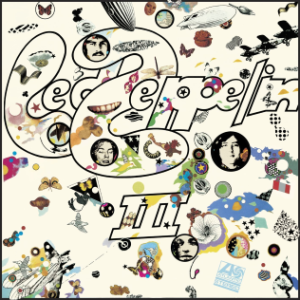Released in October 1970, Led Zeppelin III marked a significant turn in the band’s evolving sound. Known for their explosive fusion of blues, hard rock, and psychedelia on their first two albums, Led Zeppelin surprised many fans and critics with this more acoustic and folk-influenced release. While the thunderous riffs of Jimmy Page and the wailing vocals of Robert Plant had defined their early image, this third installment pulled the listener into quieter, more introspective territory.
At the time, the rock scene was leaning toward heavier, louder sounds. Black Sabbath had just released Paranoid, and the idea of “hard rock” was being cast in iron. Against this backdrop, Led Zeppelin III felt like a deliberate move sideways, not backward. It was a record shaped as much by retreat as by revelation. Page and Plant had spent time at the remote Bron-Yr-Aur cottage in Wales, seeking distance from the pressures of fame and a closer connection to traditional folk music. The result was an album that blended delicate acoustic arrangements with the band’s signature power.
Sonic Exploration

Led Zeppelin III stands out for its deliberate shift in tone, and the album’s production plays a vital role in shaping that experience. Jimmy Page, who produced the record, leaned into a more organic sound that emphasized space and texture. The production is neither overly polished nor raw; instead, it strikes a careful balance that allows both the electric and acoustic elements to breathe. Tracks like “That’s the Way” and “Bron-Y-Aur Stomp” showcase a warm, earthy quality, while heavier numbers such as “Immigrant Song” maintain the band’s trademark punch without sounding overly dense.
Musical Arrangements
The contrast in dynamics is one of the album’s most striking qualities. Page’s acoustic guitar work is crisp and intricate, recorded with a clarity that highlights every subtle strum and finger movement. Meanwhile, John Bonham’s drums still thunder when called upon, but they’re mixed with more restraint, giving the lighter tracks a sense of intimacy. Robert Plant’s vocals, too, are more varied here—less reliant on raw power and more attuned to nuance. His delivery ranges from ethereal and contemplative to fierce and commanding, reflecting the emotional breadth of the songs.
The arrangements themselves are thoughtful and often unexpected. “Friends” stands out with its use of string arrangements and an Eastern-inspired modal scale, while “Gallows Pole” builds steadily from a simple acoustic base to a frenetic climax, layering banjo, mandolin, and electric guitar in a way that feels both rooted and revolutionary. John Paul Jones’s contributions on bass and keys further enrich the sonic palette, adding subtle depth without overwhelming the core instrumentation.
In terms of genre, the album weaves through hard rock, folk, blues, country, and even touches of psychedelic music. This genre-blending was a bold move at the time and helped set Led Zeppelin III apart from its peers. It doesn’t abandon the band’s hard rock foundation but expands upon it, showing a willingness to experiment without losing their identity. While this eclecticism initially confused some fans, it ultimately proved that Led Zeppelin were not content to stay in one lane. They were exploring, stretching, and redefining what a rock band could sound like.
Lyrical Analysis

Lyrically, Led Zeppelin III explores themes of nature, introspection, mythology, and human struggle, marking a departure from the more hedonistic or blues-heavy narratives of their earlier work. There’s a sense of retreat in these songs, not just in the sound but in the words themselves. Many of the lyrics feel rooted in the pastoral, the spiritual, and the ancient, suggesting a band seeking meaning beyond the chaos of fame and the noise of the world.
The recurring theme of escape appears in several tracks. In “That’s the Way,” Plant reflects on alienation and social judgment with a quiet sadness. The song paints a picture of innocence lost and bonds broken, using plain but powerful language. “Tangerine,” a melancholic ballad about love and regret, leans into nostalgia without becoming overly sentimental. The imagery is simple—fields, seasons, color—but the emotion it evokes feels deeply personal.
On the other hand, “Immigrant Song” charges ahead with mythic fire. Inspired by the band’s visit to Iceland, its lyrics evoke Viking conquests and Norse mythology. While not deep in a literary sense, the song’s forceful repetition and tight phrasing give it a hypnotic quality. It’s an example of how lyrical simplicity can still create a vivid mood when paired with the right musical setting.
“Gallows Pole” tells a darker tale, based on a traditional folk narrative. It’s a story of desperation and bargaining, with the protagonist pleading for more time before execution. The song’s gradual build mirrors the rising tension of the lyrics, making it one of the album’s most dramatic and emotionally potent pieces.
Cohesion and Flow

Led Zeppelin III doesn’t follow a strict narrative arc, but it does create a journey through sound and mood that feels intentional and well-paced. The album opens with the explosive energy of “Immigrant Song,” a track that grabs the listener with its relentless drive and mythic imagery. It’s a bold start, almost a red herring, as the album soon settles into a quieter, more contemplative space. From there, the transition into “Friends,” with its tense acoustic strumming and string embellishments, signals the turn toward a different kind of intensity—one built on atmosphere rather than volume.
The middle portion of the album leans heavily into folk and blues influences. Tracks like “That’s the Way” and “Bron-Y-Aur Stomp” slow the tempo and deepen the emotional palette, providing a sense of intimacy and warmth. This stretch feels particularly cohesive, both sonically and thematically. The songs share a rustic, almost homespun quality that ties them together without sounding repetitive. Even “Gallows Pole,” with its darker story and more dramatic build, fits smoothly within this flow, offering contrast without breaking the mood.
Where the album falters slightly is in the sequencing of the final tracks. While “Tangerine” is a graceful, melancholic centerpiece, “Hats Off to (Roy) Harper” closes the album on a more disjointed note. Its distorted slide guitar and fragmented vocal delivery make it one of the more experimental tracks, but it also feels somewhat removed from the emotional and sonic clarity that defines the rest of the album. It’s not a poor song by any means, but its abrupt, almost chaotic energy creates a shift that might feel jarring after the subtlety of what came before.
Thematic Consistency
Despite this, the overall structure of Led Zeppelin III is strong. The album moves through phases of power and restraint, creating a rhythm that feels deliberate. The blend of acoustic and electric, folk and rock, is balanced in a way that reflects the band’s growing range. Thematic threads of nature, introspection, and myth run throughout, lending the record a quiet unity even when it changes direction. While not seamless in every moment, the album holds together as a cohesive exploration of new creative ground.
Standout Tracks and Moments
Several tracks on Led Zeppelin III rise to the surface as defining moments, each revealing a different side of the band’s evolving artistry.
Immigrant Song
Chief among them is “Immigrant Song,” which remains one of Led Zeppelin’s most iconic pieces. Its staccato riff, relentless pace, and Robert Plant’s piercing battle cry form a compact blast of power that perfectly opens the album. While lyrically minimal, the energy it unleashes is unforgettable and instantly recognizable. It captures the band’s rock prowess in just over two minutes, proving that brevity can still leave a mark.
Tangerine
“Tangerine” offers a stark contrast but stands out just as clearly. Its bittersweet tone, coupled with Page’s delicate 12-string guitar work and Plant’s reflective vocals, creates a mood of quiet sorrow. The song feels timeless—both grounded in the folk tradition and infused with personal emotion. It’s one of the album’s most heartfelt performances, showing the band’s strength in restraint.
That’s the Way
“That’s the Way” deserves mention for its emotional honesty. Stripped down and spacious, it highlights the band’s ability to let a song breathe. There’s no showmanship here, just subtle interplay between voice and guitar. The lyrics hint at loss, judgment, and the complexities of friendship, all wrapped in a melody that lingers long after it ends.
Memorable Moments
Instrumentally, “Gallows Pole” is a triumph in storytelling and arrangement. Starting with a sparse acoustic line, the song builds momentum as more instruments join the fray—banjo, electric guitar, and finally Bonham’s pounding drums. The way it escalates mirrors the desperation of the lyrics, making it not only a musical highlight but also one of the album’s most effective narrative arcs.
One of the most surprising moments comes in “Friends,” with its unusual tuning and modal scale that lend it a mystical, Eastern flavor. The tension in the chord progression, combined with Jones’s subtle string arrangements, gives the track a feeling of unease and curiosity. It’s a reminder that Zeppelin were never afraid to reach beyond their expected influences.
Even “Hats Off to (Roy) Harper,” for all its sonic oddities, offers a raw, unfiltered glimpse into the band’s blues roots. It might divide listeners, but it adds texture to the album’s landscape and underlines their willingness to take risks.
Artistic Contribution and Innovation

Led Zeppelin III occupies a distinctive place not just in the band’s catalog, but in the wider landscape of rock music at the turn of the 1970s. At a time when many rock bands were doubling down on volume and distortion, Led Zeppelin made a deliberate move toward subtlety and acoustic exploration. This shift was not only bold—it was artistically significant. The album challenged the idea that heaviness had to come from sheer force. Instead, it offered a broader definition of what rock music could be, weaving folk, blues, and even touches of world music into its fabric without losing the band’s identity.
In terms of genre, Led Zeppelin III helped pave the way for a more expansive understanding of hard rock. By integrating acoustic instruments and traditional folk structures into their sound, the band blurred the lines between electric aggression and pastoral introspection. This fusion was not entirely unprecedented, but few mainstream rock acts had attempted it with such prominence or success. The album served as an early template for what would later be explored by artists in progressive folk, acoustic rock, and even grunge, where dynamics and emotional contrast became essential tools.
Innovation
One of the album’s most innovative aspects lies in its sequencing and overall shape. It refuses to build toward a climax or follow a predictable arc. Instead, it ebbs and flows, with the softer, more reflective songs placed not just as interludes but as central moments. This structure, unusual for a rock album at the time, invites a more immersive and contemplative listening experience.
From a production standpoint, Jimmy Page’s work deserves recognition. His attention to acoustic tone, mic placement, and natural room reverb brought a richness to the quieter songs that matched the intensity of their louder counterparts. Tracks like “That’s the Way” and “Bron-Y-Aur Stomp” are not simply “unplugged” versions of rock songs—they are crafted with the same care and complexity, elevating the acoustic genre within a rock framework.
Lyrically, the album also ventures into deeper territory. While still grounded in familiar themes of love, myth, and longing, the writing feels more introspective and rooted. This shift mirrors the band’s broader artistic intent: to grow beyond their image as rock gods and explore more human, grounded dimensions.
Closing Thoughts

Led Zeppelin III is a bold and thoughtful album that showcases a band unafraid to challenge both its audience and its own legacy. The shift from the bombast of earlier records to a more nuanced and acoustic-driven sound was unexpected, but it revealed new dimensions of Led Zeppelin’s artistry. The production is warm and deliberate, the arrangements are rich with texture, and the lyrics reflect a growing emotional depth. Standout tracks like “Immigrant Song,” “Tangerine,” and “That’s the Way” demonstrate the band’s range and willingness to experiment without losing their core identity.
That said, the album isn’t without its imperfections. The final track, “Hats Off to (Roy) Harper,” while interesting, feels disconnected from the album’s emotional and sonic cohesion. A few transitions could be smoother, and some listeners might miss the full-throttle energy of the band’s earlier work. But these are minor flaws in an otherwise compelling and courageous record.
More than just a stylistic detour, Led Zeppelin III marks a critical turning point in the band’s career. It broadened their sound and laid the groundwork for future explorations in both heavy and acoustic music. For listeners, it offers a rich, layered experience—one that rewards repeat visits and invites deeper reflection.
Official Rating: 9/10
This score reflects the album’s artistic ambition, its influence on rock and folk music, and its enduring emotional resonance. It may not be perfect, but it is vital, sincere, and ahead of its time—qualities that continue to set it apart in Led Zeppelin’s legendary discography.
